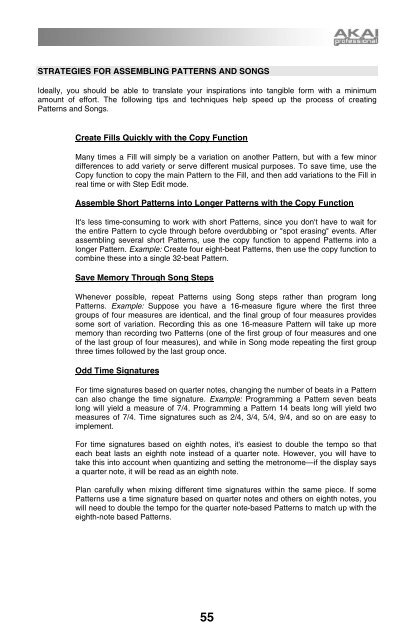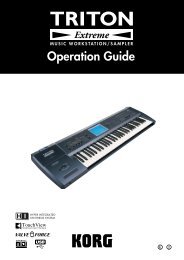Akai XR20 Reference Manual - V1.3 - zZounds.com
Akai XR20 Reference Manual - V1.3 - zZounds.com
Akai XR20 Reference Manual - V1.3 - zZounds.com
You also want an ePaper? Increase the reach of your titles
YUMPU automatically turns print PDFs into web optimized ePapers that Google loves.
STRATEGIES FOR ASSEMBLING PATTERNS AND SONGS<br />
Ideally, you should be able to translate your inspirations into tangible form with a minimum<br />
amount of effort. The following tips and techniques help speed up the process of creating<br />
Patterns and Songs.<br />
Create Fills Quickly with the Copy Function<br />
Many times a Fill will simply be a variation on another Pattern, but with a few minor<br />
differences to add variety or serve different musical purposes. To save time, use the<br />
Copy function to copy the main Pattern to the Fill, and then add variations to the Fill in<br />
real time or with Step Edit mode.<br />
Assemble Short Patterns into Longer Patterns with the Copy Function<br />
It's less time-consuming to work with short Patterns, since you don't have to wait for<br />
the entire Pattern to cycle through before overdubbing or "spot erasing" events. After<br />
assembling several short Patterns, use the copy function to append Patterns into a<br />
longer Pattern. Example: Create four eight-beat Patterns, then use the copy function to<br />
<strong>com</strong>bine these into a single 32-beat Pattern.<br />
Save Memory Through Song Steps<br />
Whenever possible, repeat Patterns using Song steps rather than program long<br />
Patterns. Example: Suppose you have a 16-measure figure where the first three<br />
groups of four measures are identical, and the final group of four measures provides<br />
some sort of variation. Recording this as one 16-measure Pattern will take up more<br />
memory than recording two Patterns (one of the first group of four measures and one<br />
of the last group of four measures), and while in Song mode repeating the first group<br />
three times followed by the last group once.<br />
Odd Time Signatures<br />
For time signatures based on quarter notes, changing the number of beats in a Pattern<br />
can also change the time signature. Example: Programming a Pattern seven beats<br />
long will yield a measure of 7/4. Programming a Pattern 14 beats long will yield two<br />
measures of 7/4. Time signatures such as 2/4, 3/4, 5/4, 9/4, and so on are easy to<br />
implement.<br />
For time signatures based on eighth notes, it's easiest to double the tempo so that<br />
each beat lasts an eighth note instead of a quarter note. However, you will have to<br />
take this into account when quantizing and setting the metronome—if the display says<br />
a quarter note, it will be read as an eighth note.<br />
Plan carefully when mixing different time signatures within the same piece. If some<br />
Patterns use a time signature based on quarter notes and others on eighth notes, you<br />
will need to double the tempo for the quarter note-based Patterns to match up with the<br />
eighth-note based Patterns.<br />
55

















